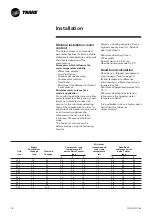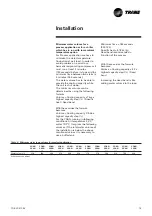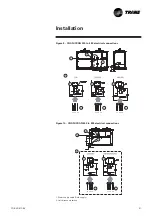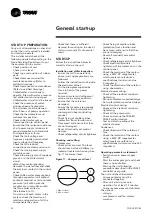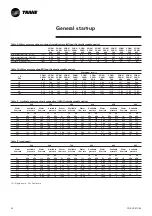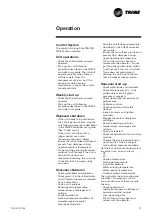
22
CG-SVX01C-E4
- Check fixing of capillary tubes
(protection from vibration and
from wear) and ensure that they
are not damaged,
- Reset all manually set control
devices,
- Check refrigerating circuits tightness
- Check electrical terminals
tightening of the motors and in the
control panel,
- Check the isolation of the motors
using a 500V DC megohmeter
which meets manufacturer's
specifications (minimum value
2 megohms)
- Check the direction of the rotation
using phasemeter.
Electrical power wiring:
- Check all the electrical terminals
tightening,
- Set-up compressors overload relays,
- Set-up fan-motors overload relays,
Electrical control wiring:
- Check all the electrical terminals
tightening,
- Check all the pressostats,
- Check and set-up the TRACER
CH532 control module
- Test and start-up without the
electrical power.
Condenser:
- Check direction of the rotation of
fans,
- Check the isolation of the motors
using a 500V DC megohmeter
which meets manufacturer's
specifications (minimum value 500
megohms)
Operating parameters statement:
- Switch on main power supply
switch,
- Start the water pump(s) and check
there is no cavitation.
- Start-up the unit following
procedure described in the CH532
controller user guide.
The unit and the chilled water
pumps contactor must be
connected together,
- After unit start up, leave in
operation for at least 15 minutes,
to ensure pressures are stabilized.
Then check:
- voltage,
- compressors and fan-motors
currents,
General start-up
START UP PREPARATION
Carry out all operations on check list
so that the unit is correctly installed
and ready to operate.
The installer must check all the
following points before calling in the
Trane Servicing Department to put
the equipment into service:
- Check position of unit
- Check unit is level
- Check type and position of rubber
pads
- Check clearance required for
maintenance access (Refer to
certified drawings)
- Check clearance around condenser
(Refer to certified drawings)
- Chilled water circuit ready to
operate, filled with water, pressure
test carried out and air purged.
- Chilled water circuit must be rinsed
- Check the presence of water
strainer ahead of evaporator
- The strainers must be cleaned
after 2 hours of pumps operation
- Check the thermometers and
manometers position
- Check chilled water pumps
interconnection to control panel
- Ensure that the isolation resistance
of all power supply terminals to
ground complies with standards
and regulations in force.
- Check that unit voltage and
frequency supplied match rated
input voltage and frequency
- Check that all electrical
connections are clean and sound -
Check that main power supply
switch is sound.
- Check Ethylene glycol or Propylene
glycol % in the chilled water
circuit.
- Water flow control checking:
decrease the water flow and check
the electrical contact in the control
panel.
- Check chilled water pressure drop
through evaporator (unit without
hydraulic module) or unit available
pressure (unit with hydraulic
module) are in accordance with
the Trane order write-up
(See tables 9 to 11).
- On start-up of each motor in the
system, check the direction of
rotation and operation of all the
components they drive
- Check that there is sufficient
demand for cooling on the day of
start-up (around 50% of nominal
load)
START-UP
Follow the instructions below to
correctly start-up the unit.
Installation and chiller inspection:
- Ensure that all the operations
above (start-up preparation), are
followed.
Follow the instruction stuck inside
the electrical cabinet:
- Put the plexiglass supplied by
Trane in front of the power
terminal.
- Ensure all water and refrigerant
valves are in service positions,
- Ensure that the unit is not
damaged,
- Ensure that sensors are properly
installed in their bulb-wells and
submerged in heat conducting
product,
- Check fixing of capillary tubes
(protection from vibration and
from wear) and ensure that they
are not damaged,
- Reset all manually set control
devices,
- Check refrigerating circuits tightness
Checking and setting:
Compressors:
- Check oil level at rest. The level
should reach at least halfway up
indicator located on housing. See
fig. 11 for correct level.
Figure 11 - Compressor oil level
1. Max. oil level
2. Min. oil level











